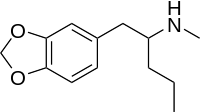1,3-Benzodioxolyl-N-methylpentanamine
N-Methyl-1,3-benzodioxolylpentanamine (MBDP; Methyl-K, UWA-091), also known as 3,4-methylenedioxy-α-propyl-N-methylphenethylamine, is a psychoactive drug of the phenethylamine chemical class. It is the N-methyl analogue of 1,3-benzodioxolylpentanamine (BDP; K). Methyl-K was first synthesized by Alexander Shulgin ("Sasha" Shulgin). In his book PiHKAL ("Phenethylamines i Have Known And Loved"), the minimum dosage is listed as 100 mg, and the duration is unknown.[1] Very little is known about the pharmacology, pharmacokinetics, effects, and toxicity of Methyl-K.
 | |
| Names | |
|---|---|
| IUPAC name
1-(1,3-benzodioxol-5-yl)-N-methylpentan-2-amine | |
| Other names
3,4-methylenedioxy-α-propyl-N-methyl-2-phenethylamine | |
| Identifiers | |
CAS Number |
|
3D model (JSmol) |
|
| ChemSpider | |
PubChem CID |
|
CompTox Dashboard (EPA) |
|
InChI
| |
SMILES
| |
| Properties | |
Chemical formula |
C13H19NO2 |
| Molar mass | 221.30 g/mol |
Except where otherwise noted, data are given for materials in their standard state (at 25 °C [77 °F], 100 kPa). | |
| Infobox references | |
Legality
United Kingdom
This substance is a Class A drug in the Drugs controlled by the UK Misuse of Drugs Act.[2]
See also
- Pentylone (bk-MBDP)
- Ethylbenzodioxolylpentanamine (EBDP; Ethyl-K)
- Methylbenzodioxolylbutanamine (MBDB; Methyl-J)
- UWA-101
References
- Methyl-K entry in PiHKAL
- "UK Misuse of Drugs act 2001 Amendment summary". Isomer Design. Retrieved 12 March 2014.
This article is issued from
Wikipedia.
The text is licensed under Creative
Commons - Attribution - Sharealike.
Additional terms may apply for the media files.